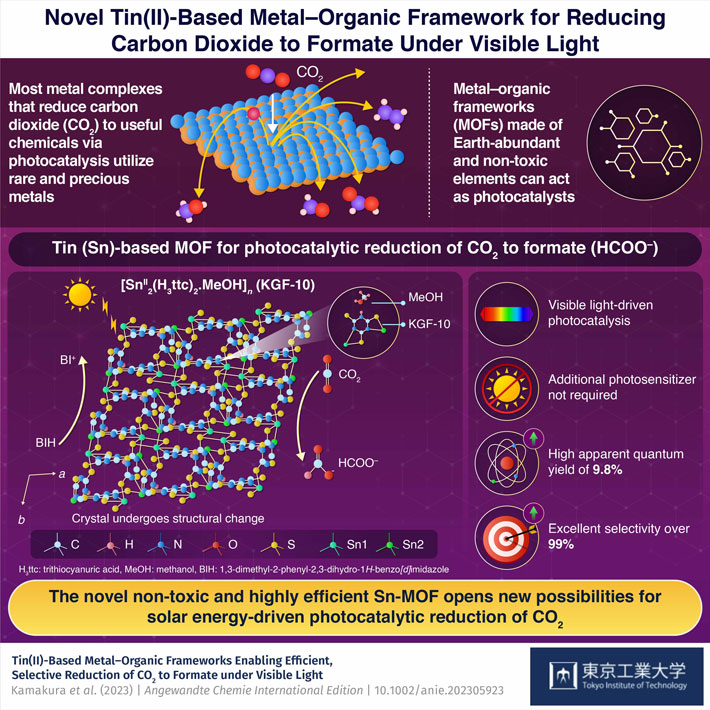The never-ending demand for carbon-rich fuels to drive the economy keeps adding more and more carbon dioxide (CO2) to the atmosphere. While efforts are being made to reduce CO2 emissions, that alone cannot counter the adverse effects of the gas already present in the atmosphere. So, scientists have come up with innovative ways to use existing atmospheric CO2 by transforming it into useful chemicals such as formic acid (HCOOH) and methanol. A popular method for carrying out such conversions is to use visible light for driving the photoreduction of CO2 via photocatalysts.
In a recent breakthrough published in Angewandte Chemie, International Edition on May 8, 2023, a team of researchers led by Prof. Kazuhiko Maeda of Tokyo Institute of Technology developed a tin-based metal–organic framework (MOF) that can enable selective photoreduction of CO2. They reported a novel tin (Sn)-based MOF called KGF-10, with the formula [SnII2(H3ttc)2.MeOH]n (H3ttc: trithiocyanuric acid and MeOH: methanol). It successfully reduced CO2 into HCOOH in the presence of visible light. "Most high-performance CO2 reduction photocatalysts driven by visible light rely on rare, precious metals as principal components. Furthermore, integrating the functions of light absorption and catalysis into a single molecular unit made up of abundant metals has remained a long-standing challenge. Hence, Sn was the ideal candidate as it can overcome both challenges," explains Prof. Maeda.
MOFs, which bring the best of both metals and organic materials, are being explored as the more sustainable alternative to conventional rare-earth metal-based photocatalysts. Sn, known for its ability to act as both a catalyst and absorber during a photocatalytic reaction, could be a promising candidate for MOF-based photocatalysts. While MOFs composed of zirconium, iron, and lead have been widely explored, not much is known about Sn-based MOFs.
For synthesizing the Sn-based MOF KGF-10, the researchers used H3ttc, MeOH, and tin chloride as the starting materials and chose 1,3-dimethyl-2-phenyl-2,3-dihydro-1H-benzo[d]imidazole as the electron donor and the hydrogen source. The prepared KGF-10 was then subjected to several analysis techniques. They revealed that the material showed moderate CO2 adsorption ability, had a bandgap of 2.5 eV, and absorbed visible light wavelengths.
Once aware of the physical and chemical properties of the new material, scientists used it for catalyzing the reduction of CO2 in the presence of visible light. They found that KGF-10 successfully reduced CO2 into formate (HCOO-) with 99% selectivity without needing any additional photosensitizer or catalyst. It also exhibited a record-high apparent quantum yield— the ratio of the number of electrons involved in the reaction to the total number of incident photons—of 9.8% at 400 nm. Furthermore, structural analysis carried out during the reactions revealed that KGF-10 underwent structural changes while facilitating photocatalytic reduction.
This study presented for the first time a tin-based high-performance, precious-metal free, and single-component photocatalyst for visible-light-driven reduction of CO2 to formate. The excellent properties of KGF-10 demonstrated by the team would open new avenues for its application as a photocatalyst in reactions such as solar energy-driven CO2 reduction. "The results of our study are a testimony to the fact that MOFs can be a platform for creating outstanding photocatalytic functions, usually unattainable with molecular metal complexes, using non-toxic, inexpensive, and Earth-abundant metals," concludes Prof. Maeda.
. Any information published on this site will be valid in relation to Science Tokyo.




